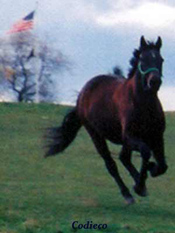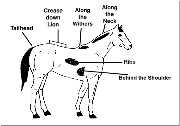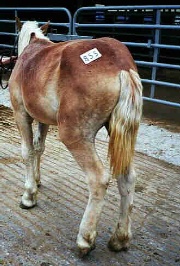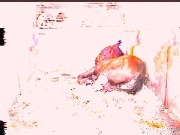
Horse Slaughter
Horse Cruelty
Horse Rescue
Legislation
Stolen Horses
Press
General
SiteMap
Horse Cruelty Info
PA Anti-Cruelty Law
Title 18, Section 5511
Henneke Body Scoring Condition Chart
 The Henneke Body Scoring Chart is accepted in court as a scientific method of scoring a horse's body condition. It is used successfully in court to prove neglect.
The Henneke Body Scoring Chart is accepted in court as a scientific method of scoring a horse's body condition. It is used successfully in court to prove neglect.
Investigating Cruelty
Successful Enforcement

PA State Police arrest horse dealer at PA horse auction
PA State Police Enforce
PA Anti-Cruelty Law at New Holland, PA Auction

Young draft gelding shipped from NC displays injured left hind leg. A PA equine vet determined that there was no fixing this horse's injured leg. He was humanely euthanised.
No Enforcement

Down and bleeding inside a trailer with Maine license plates at a New Holland, PA auction. Reportedly the horse later died. No charges were ever filed. Blood was pooling on the ground under and outside the trailer.
The Downer Hall of Shame
 Down Belgian was down all day at a PA horse auction. Several bystanders attempted to get the horse to rise. A vet was never called...
Down Belgian was down all day at a PA horse auction. Several bystanders attempted to get the horse to rise. A vet was never called...
The Labor Day Mares
Severely foundered mare's face reveals the pain she is feeling. Mare was found down on a truck at a New Holland auction. Blood oozed from her coronary bands.
A Mule & 2 Standardbreds-
All Had Broken Legs & were Hidden on A Trailer
No Water

Water tank is empty, even though the faucets work..
The Horse the Killers Refused
& the vet passed.
Unfit Horses Sold at Auction
PSPCA allows sale - NHPD files charges, owner pleads guilty.
Links
California Voters "Just Say Neigh" to Horse Slaughter!
HoofPAC
Shop online at IGive.com with over 400 great stores you know & love- including Back In the Saddle! Up to 26% of the purchase price is donated to the EPN!
Join today!The EPN gets $5 extra the first time you shop!
PayPal accepts credit cards! Please send your tax deductible donation to the:Equine Protection Network, Inc.,
P. O. Box 232, Friedensburg, PA, 17933.
HoofPAC is the political action committee that has been formed to end the slaughter of America's horses. Cathleen Doyle, founder of HoofPAC, led the successful Save The Horses campaign in 1998 that made the slaughter of California's horses a felony.

Horse Cruelty Investigations/Reporting Cruelty
New York State Humane Association Manual- How to Investigate Cruelty in NY State
Introduction
Horses are considered by many to be the most abused animal. In the United States horses are kept for sport, recreation and companionship. Cases of starvation and neglect are more common among horses than in food and fiber animals such as hogs and cattle. If farmers starved their animals, they would soon be out of business, as the animals would not produce. Horses kept for sport are not often the victims of neglect; rather they suffer cruel training practices and/or the misuse of performance enhancing or pain masking drugs.
Very few animal shelters are set up to handle horses; instead they are geared toward dogs, cats and other small animals. Horses are much more expensive to care for than dogs and cats and require specialized handling and management. In many states the law requires that the horses seized as evidence must be held until the case has been adjudicated. The law may allow for restitution to the agency holding the horses, but the court may or may not decide to award restitution, and even if awarded, the defendent may pay a bill in the thousands at a rate of a few dollars a month, if they pay at all.In Pennsylvania the non-profit organizations that have Humane Society Police Officers to investigate animal cruelty laws, do not receive money from the Commonwealth to cover the costs of enforcing a law that is in the Crimes Code, yet the fines are paid to the Commonwealth. (Any police department within Pennsylvania that has the authority to enforce the Crimes Code can enforce the cruelty law in Pennsylvania because the law is in the Crimes Code.)
Humane Society Police Officers are often not familiar with horses and lack the skills and training necessary to perform a thorough investigation that results in a successful prosecution of the offenders. Incompetent investigations result in lost cases. Humane organizations and agents are then often unwilling and hesitant to bring charges in subsequent incidents citing past unsuccessful cases. The losses are often blamed on the law itself or on the judges in the cases when in fact the cases were lost due to a poor investigation, collection of evidence and/or presentation of the evidence in court.
In the end, the evidence of the crime is often destroyed by selling the horse at auction to either a horse slaughterhouse or to buyers who have no idea or inclination to file a complaint of cruelty to horses.
Due to their unfamiliarity with horses, police are often uncomfortable investigating horse cruelty cases. Police officers are generally more skilled in investigation techniques and the collection of evidence in such crimes as burglary, kidnapping and murder, but at a loss when it comes to collecting evidence in a horse cruelty case.
Theory
Agents need to stop thinking of the horses as a horse, but rather as evidence, the same as a gun is evidence in a murder. The victims in these cases, the horses, cannot talk. Officers see that as a major problem, but in reality it is a problem that can be overcome. Dead bodies and guns cannot talk either, yet valuable evidence is still collected from both. Forensic investigators often state that the dead victim does "talk" to them through the forensic evidence left behind. Evidence of neglect and abuse can be collected from the horses; officers just need to be made aware of what evidence is necessary to collect. Veterinarians can and do perform necropsies on horses.Professionals Needed
A veterinarian whose practice is exclusively equine is the ideal licensed medical expert in court. At minimum the veterinarian should have at least fifty percent of their practice devoted to equines. A farrier is needed for areas involving hoof care.An equine dentist is needed in areas requiring dental care.
Professionals who transport horses are needed to move horses that are seized as evidence because horses do not fit in police cars. Professionals who are trained in horse management are needed to house the horses, as again, horses do not fit in the police evidence locker. These professionals need to be trained how to hold evidence, which in this case is the horse, according to the Rules of Evidence.
In most states people who transport horses as a business must be licensed and/or registered with the state.
Materials Needed
Graphics needed include a picture of a horse listing all points or body parts of a horse; a color and markings chart; the Henneke Body Scoring Condition Chart; pictures of a normal hooves and pictures of abnormal or overgrown and neglected hooves; examples of shelter. When investigating any complaint involving horses the first question has to be, "Who owns this horse?" "Who takes care of this horse?"Photographs
As in any other crime investigation, photographs must be taken. Photographs documenting the entire scene need to be taken from all directions and the positions noted. When photographing a horse, photographs of the horse from the front, rear and both sides must be taken. All of the horse's markings and or injuries must be photographed. Emaciated horses need to be taken from several angles. An overhead angle can be very effective at showing the horse's spine. Light colored horses do not show emaciation as well in photographs as dark colored horses. Expect to take at least 24 pictures of one horse.Photographs of feed, water sources, shelter and any hazardous objects or material should also be taken. Any dead animals must also be photographed. Overgrown hooves need to be photographed with a ruler to prove the length of the hoof. Photographs must be taken from the front, side and the bottom of the hoof.
In one court hearing the EPN attended the prosecution testified to the overgrown condition of the horses hooves. Yet the only picture introduced into evidence, depicted a hoof that was properly trimmed and had hoof dressing applied. (Hoof dressing is applied in certain horse disciplines before showing as a means of giving the hoof a well groomed appearance.) Needless to say the charges were dismissed due to a lack of evidence.
Overgrown Hooves
The equine industry standard for trimming a horse's hooves is every 6 to 8 weeks. Horses that are wearing shoes have new shoes or their shoes reset every 4 to 6 weeks.Allowing a horse to go several weeks beyond these standards is considered bad management and not cruelty, unless it causes lameness. When the horse's hoof becomes split to the point that it resembles a cloven hoof, or the hooves have overgrown to the point that it appears the horse has skis or "elf feet".
X-rays need to be taken to assess the internal damage to the foot. The X-rays must be properly labeled and identified so as to identify the subject of the X-ray and the date the film was taken. The EPN attended a horse cruelty hearing where the veterinarian testifying could not testify that the X-Ray in evidence was of the horse in question, as the X-ray was not labeled by the original veterinarian who took the X-Ray. The case was dismissed. The humane agent blamed the loss on the law and the court, when in fact the loss was due to poor collection and presentation of evidence.
When a horse with overgrown hooves is taken into custody, the portion of the hoof that is trimmed must be kept as evidence.
Sick Horses
Horses that have obvious signs of infection such as pus and elevated fevers, untreated open wounds, and down horses are all examples of horses that are in need of medical attention. To prove intent owners must be given the chance to treat the horse. After being informed of the problem the owner is given an appropriate time frame to have the horse treated by a veterinarian. Law enforcement unfamiliar with horse health and injuries will need to consult with a horse professional or expert to determine the amount of time to allow the owner to obtain veterinary care.Horses with broken legs, down horses that are unable or unwilling to rise, and bleeding horses are all horses that are in need of immediate veterinarian care.
Thin Horses
The Henneke Body Scoring Condition Chart is used to determine a horse's body condition. A score between 4 and 7 is acceptable with 5 being considered ideal.The first clue to a horse's body condition is angles. A horse should be round over their hindquarters and their back. A horse's hipbones and spine should not be protruding. A horse's heavy winter hair coat can conceal how thin the horse really is. When looking at a horse from the rear or side if you view angles, that is a good indicator that you need to investigate further and perform the Henneke System on the horse.
An obvious question to ask the owner or caretaker of the horse is,
"Why is this horse thin?"Horses can be thin for several reasons:
- Lack of sufficient food.
- Parasite infestation
- Poor teeth
- Disease such as kidney or liver failure.
- Who is your veterinarian?
- Has your veterinarian been out to see this horse?
- When?
- What did the veterinarian do?
- When is the veterinarian due out again?
- When was the last time you dewormed this horse?
- And when did you deworm it before then?
- What dewormer did you use?
- Have you had this horse's teeth done?
- When?
- Who floated the horse's teeth?
- What do you feed this horse?
- How much do you feed this horse?
- When do you feed this horse?
- How often do you feed this horse?
Depending on the horse's body condition the officer can give the owner 1 hour to 1 week to get a veterinarian out to examine the horse. Horses that are in a poor condition and down need a vet immediately. Horses rated a 3 on the Henneke Chart can be seen within a week.
Investigators need to be present when the veterinarian is examining the horse the same as an investigator is present when an autopsy is performed. Blood drawn by the veterinarian can determine if the horse has problems with any major organs, anemia, disease and dehydration. Fecal tests can determine a horse's internal parasite load.
Owners of thin horses have three common excuses as to why their horse is thin. All are easily proved or disproved by a few simple questions, paperwork, and a veterinarian.
Excuses that owners provide for their horses being thin:
- I just bought the horse.
- The horse is sick.
- The horse is old.
- Bill of sale
- Cancelled check
- Cancelled check or bill of lading for the transportation of the horse.
- Name of former owner
- Registration papers, health charts, etc.
Often owners will not be able to produce any of this paperwork as business in the horse industry is often conducted with cash. If the horse was purchased at an auction, the auction would have records of the sale. If purchased from a horse dealer, many states, including Pennsylvania require horse dealers to keep such records as to identify horses that they have bought and sold, and the dates of such transactions. Failure to produce such documentation can result in criminal charges against the dealer.
If the owner uses the excuse that the horse is old, then the owner needs to have a vet examine the horse to determine the horse's age, determine whether or not the horse is in need of dental work, determine whether or not the horse is suffering from a disease or cancer and to recommend a feeding program for the horse.
There are several feeds on the market especially designed for older horses, old age is no excuse for a horse to be thin.
If the owner uses the excuse that the horse is sick than the logical question is,
"Has a vet seen the horse?"
If the horse is sick, than the horse needs veterinarian care. Under Pennsylvania cruelty laws, owners are required to provide their horse with necessary vet care.
Cases of horses that have died from apparent neglect need to be handled in the same way as a human death. A necropsy needs to be performed to determine why the horse died. Pictures of a thin horse do not prove why or when the horse died.
To prove intent the owner is given a certain amount of time to improve the horse's body condition. The agent needs to base this determination on the findings of the veterinarians examination. If within a month there is no improvement in the horse's body condition then the agent needs to confer with their equine vet and determine whether or not to seize the horse.
Seizure of Horses
Upon seizing the horse the law enforcement agency's veterinarian needs to perform a physical exam and draw blood for lab work that determines if a horse is dehydrated, anemic, and if all of the bodies organ systems are functioning normally. This exam needs to be done ideally before the horse is removed from the owner's premises or as soon as the horse is unloaded at the facility chosen by law enforcement to hold the horse.The horse is now placed under the care of the veterinarian who will issue all the orders for the care of the horse. This is the same procedure that is followed in a hospital.
All procedures that are performed on the horse must be recorded and logged. The horse is evidence, and the chain of evidence must be maintained as required by law.
Periodically as the horse improves more pictures and lab work can be taken to demonstrate the horse's improvement.
Shelter
Pennsylvania cruelty law requires that horses be provided shelter that is sanitary, protects them from inclement weather, allows the horse to maintain his body heat and keeps the horse dry.Accepted shelter in the equine industry is a three-sided shed with a roof that faces south or away from the prevailing winds. Owners either have shelter or they do not. Trees only qualify as shelter if the horse can stand under the trees and remain dry and warm and (maintain body heat.)
Horses are often turned out in paddocks for a few hours without shelter. The test to determine whether or not the cruelty law is being violated is to speak to the owners regarding their management practices. If the owners state that they bring the horses in when they come home from work, then the officer needs to investigate if that statement is true by returning to the property after the time designated by the owner as to when they provide the horse shelter.
A horse that is shivering is in violation of the law. Often in court defendants use the defense that horses "out west" or "wild horses" do not have shelter as a defense. This defense is stopped (refuted) by the fact that the law is in Pennsylvania, not out west and the case is regarding domestic horses, not wild horses.
Warnings
Do not make sudden moves around horses. Do not walk up behind a horse without first talking to the horse. Speak to the horse to make him aware that you are approaching. Be aware of horses whose ears are pinned flat against their heads. When walking behind a horse if you cannot walk out of their kicking range, then walk right next to the horse. Make sure you talk to the horse as you walk behind him.Glossary
Deworm - Administering medication that kills internal parasites. Horses are dewormed every 8 weeks. Daily dewormers are also available.
Equine- horse, mule, donkey, pony.
Farrier - Person who is trained to trim a horse's hooves and to make and fit shoes for horses.
Teeth Floating - Filing down of a horse's teeth. A horse's teeth are continually growing. Horses can develop sharp hooks that prevent a horse from properly chewing their food. Older horses can lose teeth and need to be fed special feed designed especially for older horses. Usually performed by an equine dentist or veterinarian. Equine industry standard is a minimum of once a year.
Henneke Body Scoring Condition Chart - Scientific method used to score a horse's body condition developed by Dr. Henneke.
Conclusion
This webpage is not intended to train people in the rules of evidence, the chain of evidence, or interrogation techniques. The instructions provided here are for people already trained in these areas who are seeking more information on the evidence needed for the successful prosecution of cases of horse neglect.From UC Davis:
Refeeding the Starved Horse
Save America's Horses!
|
|||||||
